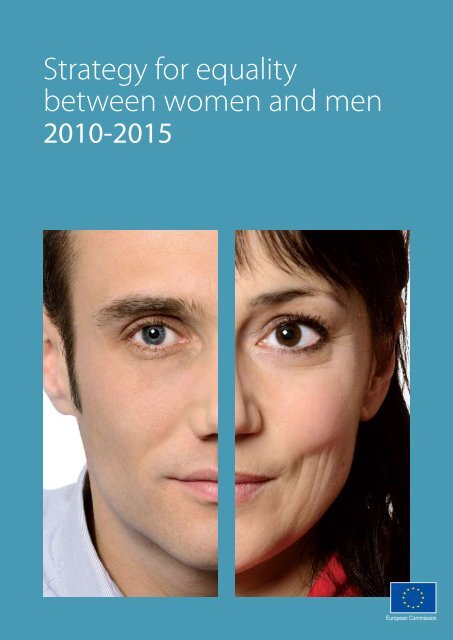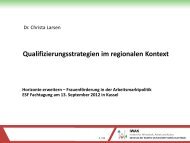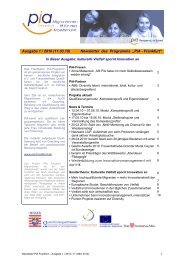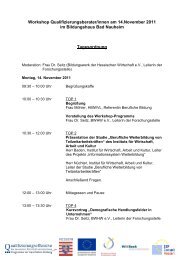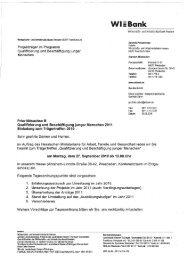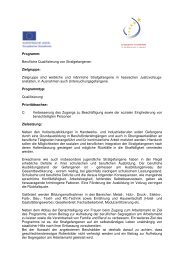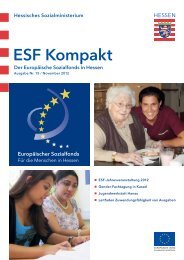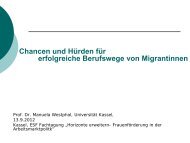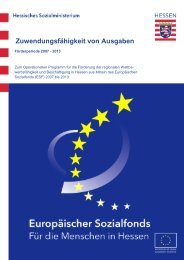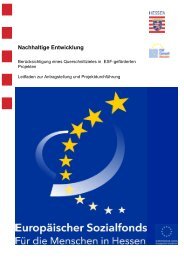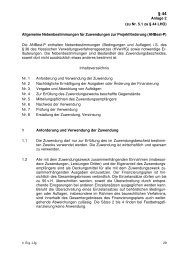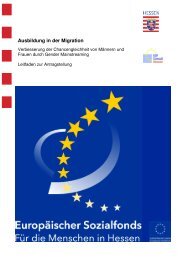Strategy for equality between women and men - European ...
Strategy for equality between women and men - European ...
Strategy for equality between women and men - European ...
You also want an ePaper? Increase the reach of your titles
YUMPU automatically turns print PDFs into web optimized ePapers that Google loves.
<strong>Strategy</strong> <strong>for</strong> <strong>equality</strong><br />
<strong>between</strong> <strong>wo<strong>men</strong></strong> <strong>and</strong> <strong>men</strong><br />
2010-2015
<strong>Strategy</strong> <strong>for</strong> <strong>equality</strong><br />
<strong>between</strong> <strong>wo<strong>men</strong></strong> <strong>and</strong> <strong>men</strong><br />
2010-2015<br />
<strong>European</strong> Commission<br />
<strong>Strategy</strong> adopted in September 2010
Docu<strong>men</strong>t drawn up on the basis of COM(2010) 491 final, SEC(2010) 1079 <strong>and</strong> SEC(2010) 1080.<br />
Neither the <strong>European</strong> Commission nor any person acting on behalf of the Commission may be held responsible <strong>for</strong> the<br />
use that may be made of the in<strong>for</strong>mation contained in this publication.<br />
© Pictures: <strong>European</strong> Union<br />
For any use or reproduction of photos which are not under <strong>European</strong> Union copyright, permission must be sought<br />
directly from the copyright holder(s).<br />
More in<strong>for</strong>mation on the <strong>European</strong> Union is available on the Internet (http://europa.eu).<br />
Cataloguing data as well as an abstract can be found at the end of this publication.<br />
Luxembourg: Publications Office of the <strong>European</strong> Union, 2011<br />
ISBN 978-92-79-16981-6<br />
doi:10.2767/71254<br />
© <strong>European</strong> Union, 2011<br />
Reproduction is authorised provided the source is acknowledged.<br />
Printed in Belgium<br />
Pr i n t e d o n ele<strong>men</strong>tal c h l o r i n e-f r e e bleached P a P e r (e c f )<br />
Europe Direct is a service to help you<br />
find answers to your questions about<br />
the <strong>European</strong> Union<br />
Freephone number (*):<br />
00 800 6 7 8 9 10 11<br />
(*) Certain mobile telephone operators do not allow access<br />
to 00 800 numbers or these calls may be billed.
Foreword<br />
Equality <strong>between</strong> <strong>wo<strong>men</strong></strong> <strong>and</strong> <strong>men</strong> is one of the <strong>European</strong> Union’s<br />
founding principles. It goes back to 1957 when the principle of<br />
equal pay <strong>for</strong> equal work became part of the Treaty of Rome.<br />
Much progress has been made in getting more <strong>wo<strong>men</strong></strong> into the<br />
work<strong>for</strong>ce. The EU average is now close to 60 percent, up from<br />
52 percent in 1998. The <strong>European</strong> Commission is aiming <strong>for</strong> a<br />
rate of 75 percent <strong>for</strong> <strong>men</strong> <strong>and</strong> <strong>wo<strong>men</strong></strong> by 2020.<br />
It is clear that more <strong>wo<strong>men</strong></strong> need to be part of the work<strong>for</strong>ce to reach that goal <strong>and</strong> to get<br />
Europe’s economic engine moving again. Europe should make better use of <strong>wo<strong>men</strong></strong>’s talents<br />
– they are problem solvers <strong>and</strong> excellent at multi-tasking.<br />
The <strong>European</strong> Commission adopted a Wo<strong>men</strong>’s Charter on 5 March 2010 <strong>and</strong> committed to<br />
strengthening gender <strong>equality</strong> in all its policies. To translate the Wo<strong>men</strong>’s Charter’s objectives<br />
into reality, we adopted an action plan <strong>for</strong> promoting <strong>equality</strong> <strong>between</strong> <strong>men</strong> <strong>and</strong> <strong>wo<strong>men</strong></strong> –<br />
the Gender Equality <strong>Strategy</strong>.<br />
The actions in the <strong>Strategy</strong> will help us address some of the remaining gender gaps.<br />
The gender gap in the employ<strong>men</strong>t rate was 12 percentage points in 2009. We will work to<br />
improve <strong>wo<strong>men</strong></strong>’s participation in the labour market by facilitating the work-life balance,<br />
promoting female entrepreneurship <strong>and</strong> working with Member States on the availability of<br />
af<strong>for</strong>dable high-quality child care.<br />
The gender pay gap (the average difference <strong>between</strong> <strong>men</strong>’s <strong>and</strong> <strong>wo<strong>men</strong></strong>’s hourly gross<br />
earnings across the economy as a whole) in the EU remains at 18%. With the <strong>European</strong> Social<br />
partners, we will work on improving the transparency of pay schemes. Raising awareness is<br />
also crucial. The <strong>European</strong> Commission will there<strong>for</strong>e introduce a <strong>European</strong> Equal Pay Day as<br />
from 2011 so that every year it can “visualise” how much longer <strong>wo<strong>men</strong></strong> need to work than<br />
<strong>men</strong> to earn the same amount.<br />
We also need to make sure that <strong>wo<strong>men</strong></strong>’s careers are not blocked by a glass ceiling effect.<br />
Today, only one out of ten members of the manage<strong>men</strong>t boards of large publicly listed EU<br />
companies is a woman. The <strong>European</strong> Commission will work together with the private sector<br />
to raise the number of <strong>wo<strong>men</strong></strong> in economic decision-making positions – either through selfregulation<br />
or an EU initiative.<br />
Gender <strong>equality</strong> is more than just a slogan; it is our social <strong>and</strong> economic responsibility. I am<br />
confident that together, we can make it happen.<br />
Viviane Reding<br />
Vice-President of the <strong>European</strong> Commission<br />
Justice, Funda<strong>men</strong>tal Rights <strong>and</strong> Citizenship<br />
3
Contents<br />
Introduction<br />
Foreword ..................................................................................................................................................... 3<br />
Introduction .............................................................................................................................................. 7<br />
1. Equal economic independence ........................................................................................ 11<br />
2. Equal pay <strong>for</strong> equal work <strong>and</strong> work of equal value ............................................... 15<br />
3. Equality in decision-making ................................................................................................ 19<br />
4. Dignity, integrity <strong>and</strong> an end to gender-based violence .................................. 23<br />
5. Gender <strong>equality</strong> in external actions ................................................................................ 27<br />
6. Horizontal issues ......................................................................................................................... 31<br />
Annexes<br />
A) Glossary of main terms .............................................................................................................................38<br />
B) <strong>European</strong> <strong>for</strong>a <strong>and</strong> institutions which deal with gender <strong>equality</strong> .................................39<br />
5
Introduction
<strong>Strategy</strong> <strong>for</strong> <strong>equality</strong> <strong>between</strong> <strong>wo<strong>men</strong></strong> <strong>and</strong> <strong>men</strong> – 2010–2015<br />
The <strong>European</strong> Union’s achieve<strong>men</strong>ts in fostering <strong>equality</strong> <strong>between</strong> <strong>wo<strong>men</strong></strong> <strong>and</strong> <strong>men</strong><br />
have helped to change the lives of many <strong>European</strong> citizens <strong>for</strong> the better <strong>and</strong> provide the<br />
foundation on which we now have to build a genuinely gender-equal society.<br />
In 1975, the principle of equal pay <strong>for</strong> equal work was successfully invoked to defend Gabrielle<br />
Defrenne, who was an air hostess working <strong>for</strong> the Belgian national airline, <strong>and</strong> the rights<br />
stemming from the Defrenne cases are an unshakable legacy <strong>for</strong> <strong>wo<strong>men</strong></strong> in the <strong>European</strong><br />
Union. The case led to the adoption of the first <strong>European</strong> directives on gender <strong>equality</strong>.<br />
Some encouraging recent trends include the increased number of <strong>wo<strong>men</strong></strong> on the labour<br />
market <strong>and</strong> their progress in securing better education <strong>and</strong> training. However, gender gaps<br />
remain in many areas <strong>and</strong> in the labour market <strong>wo<strong>men</strong></strong> are still over-represented in lower<br />
paid sectors <strong>and</strong> under-represented in decision-making positions. Parenthood keeps female<br />
employ<strong>men</strong>t rates down, <strong>and</strong> <strong>wo<strong>men</strong></strong> continue to work more unpaid hours than <strong>men</strong><br />
at home.<br />
Inequalities <strong>between</strong> <strong>wo<strong>men</strong></strong> <strong>and</strong> <strong>men</strong> violate funda<strong>men</strong>tal rights. They also impose a<br />
heavy toll on the economy <strong>and</strong> result in underutilisation of talent. On the other h<strong>and</strong>,<br />
economic <strong>and</strong> business benefits can be gained from enhancing gender <strong>equality</strong> (1) . In<br />
order to achieve the objectives of Europe 2020 (2) , namely smart, sustainable <strong>and</strong> inclusive<br />
growth, the potential <strong>and</strong> the talent pool of <strong>wo<strong>men</strong></strong> need to be used more extensively <strong>and</strong><br />
more efficiently.<br />
Gender roles continue to influence crucial individual decisions: on education, on career<br />
paths, on working arrange<strong>men</strong>ts, on family <strong>and</strong> on fertility. These decisions in turn have an<br />
impact on the economy <strong>and</strong> society. It is there<strong>for</strong>e in everyone’s interest to offer genuine<br />
choices equally <strong>for</strong> <strong>wo<strong>men</strong></strong> <strong>and</strong> <strong>men</strong> throughout the different stages of their lives.<br />
Equality is one of five values on which the Union is founded. The Union is bound to strive <strong>for</strong><br />
<strong>equality</strong> <strong>between</strong> <strong>wo<strong>men</strong></strong> <strong>and</strong> <strong>men</strong> in all its activities (3) . The Charter of Funda<strong>men</strong>tal Rights (4)<br />
provides <strong>for</strong> such <strong>equality</strong> <strong>and</strong> prohibits sex discrimination.<br />
In March 2010, to mark the 15th anniversary of the declaration <strong>and</strong> plat<strong>for</strong>m <strong>for</strong> action<br />
adopted at the Beijing UN World Conference on Wo<strong>men</strong> <strong>and</strong> the 30th anniversary of<br />
the UN Convention on the Elimination of All Forms of Discrimination against Wo<strong>men</strong>,<br />
the Commission adopted the Wo<strong>men</strong>’s Charter (5) , in which the Commission renewed its<br />
commit<strong>men</strong>t to gender <strong>equality</strong> <strong>and</strong> to strengthening the gender perspective in all its<br />
policies.<br />
Building on the Roadmap <strong>for</strong> <strong>equality</strong> <strong>between</strong> <strong>wo<strong>men</strong></strong> <strong>and</strong> <strong>men</strong> 2006-2010, as well as<br />
the <strong>European</strong> Pact <strong>for</strong> Gender Equality (6) , this <strong>Strategy</strong> spells out actions under five priority<br />
areas defined in the Wo<strong>men</strong>’s Charter, <strong>and</strong> one area addressing cross-cutting issues. For<br />
each priority area, key actions to stimulate change <strong>and</strong> achieve progress are described<br />
<strong>and</strong> more detailed proposals are to be found in the accompanying staff working paper*.<br />
* Commission staff working docu<strong>men</strong>t, “Actions to imple<strong>men</strong>t the <strong>Strategy</strong> <strong>for</strong> Equality <strong>between</strong> Wo<strong>men</strong> <strong>and</strong> Men (2010-2015)” – SEC(2010) 1079 final.<br />
Another staff working docu<strong>men</strong>t provides the background in<strong>for</strong>mation used <strong>for</strong> the preparation of the <strong>Strategy</strong>, “Background docu<strong>men</strong>t accompanying<br />
the <strong>Strategy</strong> <strong>for</strong> Equality <strong>between</strong> Wo<strong>men</strong> <strong>and</strong> Men 2010-2015” - SEC(2010) 1080 final.<br />
(1) Council Conclusions on Gender <strong>equality</strong>: strengthening growth <strong>and</strong> employ<strong>men</strong>t, 2980th EPSCO Council meeting, 30.11.2009.<br />
(2) COM(2010) 2020.<br />
(3) Articles 2 <strong>and</strong> 3 TEU, Article 8 TFEU.<br />
(4) OJ C 303, 14.12.2007, p. 1, Article 23.<br />
(5) COM (2010) 78.<br />
(6) <strong>European</strong> Council conclusions, March 2006, 7775/1/06.
Facts <strong>and</strong> figures<br />
Introduction<br />
The actions proposed follow the dual approach of gender mainstreaming (meaning the<br />
integration of the gender di<strong>men</strong>sion in all policy areas) <strong>and</strong> specific measures. The <strong>Strategy</strong><br />
represents the work programme of the <strong>European</strong> Commission on gender <strong>equality</strong>, aiming<br />
additionally to stimulate develop<strong>men</strong>ts at national level <strong>and</strong> to provide the basis <strong>for</strong><br />
cooperation with the other <strong>European</strong> institutions <strong>and</strong> with stakeholders.<br />
Eurobarometer survey: Gender <strong>equality</strong> in the EU in 2009 <br />
A survey on perceptions <strong>and</strong> experiences of <strong>European</strong>s with regard to gender <strong>equality</strong><br />
was conducted <strong>between</strong> September <strong>and</strong> October 2009. The results were published in<br />
March 2010.<br />
62 % of the respondents believe that gender in<strong>equality</strong> is a widespread pheno<strong>men</strong>on.<br />
However, their perception of the extent of gender in<strong>equality</strong> increases with age: the<br />
young generation (15-24) tends to regard gender in<strong>equality</strong> as less widespread than<br />
the older age group (55+).<br />
Violence against <strong>wo<strong>men</strong></strong> <strong>and</strong> the gender pay gap are considered as the two top priorities<br />
<strong>for</strong> action selected by <strong>European</strong>s from a list of options: 62 % <strong>for</strong> violence against <strong>wo<strong>men</strong></strong><br />
<strong>and</strong> 50 % <strong>for</strong> the gender pay gap, <strong>and</strong> a large majority of <strong>European</strong>s think these issues<br />
should be addressed urgently (92 % <strong>for</strong> violence against <strong>wo<strong>men</strong></strong> <strong>and</strong> 82 % <strong>for</strong> the gender<br />
pay gap).<br />
Most of the respondents think that decisions about gender <strong>equality</strong> should be made<br />
jointly within the <strong>European</strong> Union, 64 % believe there has been progress in the past<br />
decade <strong>and</strong> over half are aware of the EU’s activities to combat gender inequalities.<br />
Gender <strong>equality</strong> in the EU in 2009, Special Eurobarometer survey 326.<br />
9
1.<br />
Equal economic<br />
independence
2<br />
<strong>Strategy</strong> <strong>for</strong> <strong>equality</strong> <strong>between</strong> <strong>wo<strong>men</strong></strong> <strong>and</strong> <strong>men</strong> – 2010–2015<br />
Economic independence is a prerequisite <strong>for</strong> enabling both <strong>wo<strong>men</strong></strong> <strong>and</strong> <strong>men</strong> to exercise<br />
control over their lives <strong>and</strong> to make genuine choices. Earning one’s own living is the main<br />
way to achieve this <strong>and</strong> there has been progress in the participation of <strong>wo<strong>men</strong></strong> on the labour<br />
market during the last decade, with the female employ<strong>men</strong>t rate rising to 62.5% (7) . In the EU,<br />
<strong>wo<strong>men</strong></strong> accounted <strong>for</strong> 9.8 million out of 12.5 million additional employ<strong>men</strong>t <strong>between</strong> 2000<br />
<strong>and</strong> 2009. This increased participation has contributed to economic growth in the EU.<br />
Getting more <strong>wo<strong>men</strong></strong> on to the labour market helps counterbalance the effects of a shrinking<br />
working-age population, thereby reducing the strain on public finances <strong>and</strong> social protection<br />
systems, widening the human capital base <strong>and</strong> raising competitiveness. Measures to facilitate<br />
work-life balance can have a positive impact on fertility. To reach the Europe 2020 objective<br />
of a 75% employ<strong>men</strong>t rate <strong>for</strong> <strong>wo<strong>men</strong></strong> <strong>and</strong> <strong>men</strong>, particular attention needs to be given to<br />
the labour market participation of older <strong>wo<strong>men</strong></strong>, single parents, <strong>wo<strong>men</strong></strong> with a disability,<br />
migrant <strong>wo<strong>men</strong></strong> <strong>and</strong> <strong>wo<strong>men</strong></strong> from ethnic minorities. The employ<strong>men</strong>t rates of these groups<br />
are still relatively low <strong>and</strong> remaining gender gaps need to be reduced in both quantitative<br />
<strong>and</strong> qualitative terms (8) .<br />
The impact of parenthood on labour market participation is still very different <strong>for</strong> <strong>wo<strong>men</strong></strong><br />
<strong>and</strong> <strong>men</strong> in the EU today because <strong>wo<strong>men</strong></strong> continue to shoulder a disproportionate part<br />
of the responsibilities involved in running a family. Many <strong>wo<strong>men</strong></strong> feel that they still have<br />
to choose <strong>between</strong> a career <strong>and</strong> their children. Current demographic trends also mean<br />
that <strong>wo<strong>men</strong></strong> <strong>and</strong> <strong>men</strong> increasingly have to care <strong>for</strong> dependants other than children over<br />
indefinite periods of time. Member States which have put reconciliation policies in place are<br />
seeing high numbers of both <strong>wo<strong>men</strong></strong> <strong>and</strong> <strong>men</strong> in work <strong>and</strong> relatively sustainable birth rates.<br />
The EU has made recent progress in improving the overall framework <strong>for</strong> a better work/<br />
life balance (9) . The Commission will strive <strong>for</strong> further progress in this area, paying particular<br />
attention to the availability of af<strong>for</strong>dable high-quality care.<br />
The proportion of female entrepreneurs, at 33% (10) (30% in start-ups), is some way short of<br />
optimum <strong>and</strong> most <strong>wo<strong>men</strong></strong> still do not consider entrepreneurship as a relevant career option.<br />
The imple<strong>men</strong>tation of the revised directive (11) on self-employed <strong>wo<strong>men</strong></strong> should remove a<br />
major barrier to female entrepreneurship (12) . Young <strong>wo<strong>men</strong></strong> should also benefit from the<br />
growing emphasis on entrepreneurship as one of the basic skills that schools should teach<br />
all pupils, as <strong>for</strong>eseen in the Youth on the Move flagship initiative (13) .<br />
The employ<strong>men</strong>t rate of migrant <strong>wo<strong>men</strong></strong> is still low (14) especially during the first three years in<br />
the host country. For this reason, there is a strong need to provide early support to migrant<br />
<strong>wo<strong>men</strong></strong> <strong>and</strong> monitor the effect of such assistance. Making them more aware of their rights<br />
<strong>and</strong> facilitating their integration <strong>and</strong> access to education <strong>and</strong> health care is crucial.<br />
(7) From 57.3% to 62.5% <strong>between</strong> 2000 <strong>and</strong> 2009 (age group 20-64).<br />
(8) See, in particular, Employ<strong>men</strong>t Guideline 7, Council docu<strong>men</strong>t 10907/10, 9.6.2010.<br />
(9) COM(2008) 635, Directive 2010/18/EU imple<strong>men</strong>ting the revised Framework Agree<strong>men</strong>t on parental leave (OJ L 68, 18.3.2010, p. 13); Directive<br />
2010/41/EU of the <strong>European</strong> Parlia<strong>men</strong>t <strong>and</strong> of the Council of 7 July 2010 on the application of the principle of equal treat<strong>men</strong>t <strong>between</strong> <strong>men</strong><br />
<strong>and</strong> <strong>wo<strong>men</strong></strong> engaged in an activity in a self-employed capacity <strong>and</strong> repealing Council Directive 86/613/EEC (OJ L 180, 15.7.2010).<br />
(10) Labour Force Survey, 2008.<br />
(11) See footnote 9.<br />
(12) See also Employ<strong>men</strong>t Guideline 8.<br />
(13) COM(2010) 477.<br />
(14) Conclusions of the Council <strong>and</strong> the Representatives of the Govern<strong>men</strong>ts of the Member States on Integration as a Driver <strong>for</strong> Develop<strong>men</strong>t <strong>and</strong> Social<br />
Cohesion, 10307/10, 3.6.2010.
Facts <strong>and</strong> figures<br />
100%<br />
90%<br />
80%<br />
70%<br />
60%<br />
50%<br />
40%<br />
30%<br />
20%<br />
10%<br />
0%<br />
39.8<br />
76.9<br />
MT<br />
49.7<br />
73.8<br />
IT<br />
52.7<br />
EL<br />
78.8<br />
54.4<br />
67.0<br />
HU<br />
Employ<strong>men</strong>t rates (<strong>wo<strong>men</strong></strong> <strong>and</strong> <strong>men</strong> aged 20-64) in EU Member States - 2009<br />
56.3<br />
RO<br />
70.7<br />
56.3<br />
Source: Eurostat, Labour Force Survey (LFS), annual averages.<br />
71.0<br />
ES<br />
57.6<br />
PL<br />
72.6<br />
58.2<br />
74.6<br />
SK<br />
61.0<br />
BE<br />
73.2<br />
61.4<br />
80.2<br />
CZ<br />
61.5<br />
LU<br />
79.0<br />
61.7<br />
IE<br />
71.8<br />
62.5<br />
75.8<br />
EU27<br />
64.0<br />
BG<br />
73.8<br />
65.1<br />
FR<br />
74.2<br />
66.1<br />
76.5<br />
PT<br />
67.5<br />
66.9 67.9<br />
66.8 67.4<br />
LV<br />
LT<br />
1. Equal economic independence<br />
75.6<br />
SI<br />
68.1<br />
CY<br />
83.5<br />
68.2<br />
79.6<br />
UK<br />
68.8 69.4<br />
71.0<br />
EE<br />
80.1<br />
AT<br />
69.8<br />
79.7<br />
DE<br />
74.7 72.7<br />
72.4<br />
FI<br />
84.9<br />
NL<br />
Wo<strong>men</strong><br />
Men<br />
74.8<br />
80.8<br />
DK<br />
75.7<br />
80.9<br />
SE<br />
Europe 2020 target<br />
<strong>for</strong> total employ<strong>men</strong>t rate<br />
Lisbon target <strong>for</strong> total<br />
employ<strong>men</strong>t rate in 2010<br />
Lisbon target <strong>for</strong> <strong>wo<strong>men</strong></strong>’s<br />
employ<strong>men</strong>t rate in 2010<br />
13
4<br />
<strong>Strategy</strong> <strong>for</strong> <strong>equality</strong> <strong>between</strong> <strong>wo<strong>men</strong></strong> <strong>and</strong> <strong>men</strong> – 2010–2015<br />
The ways in which <strong>wo<strong>men</strong></strong> <strong>and</strong> <strong>men</strong> experience poverty <strong>and</strong> social exclusion are still quite<br />
different. Wo<strong>men</strong> face a higher poverty risk, particularly lone parents <strong>and</strong> the elderly,<br />
when the pay gap becomes a ‘pension gap’. Barriers to employ<strong>men</strong>t are also reflected in<br />
higher inactivity rates <strong>and</strong> higher long-term unemploy<strong>men</strong>t rates. In addition, amongst<br />
disadvantaged groups (i.e. migrant workers, disabled, elderly) gender gaps tend to be<br />
much wider <strong>and</strong> cause many problems <strong>for</strong> <strong>wo<strong>men</strong></strong>. Active ageing policies <strong>and</strong> specific<br />
measures in the pension sector are needed to ensure that <strong>wo<strong>men</strong></strong> have adequate means<br />
when they retire (15) .<br />
Key Actions<br />
The Commission will:<br />
• Support the promotion of gender <strong>equality</strong> in the imple<strong>men</strong>tation of all aspects <strong>and</strong><br />
flagship initiatives of the Europe 2020 strategy, especially as regards definition <strong>and</strong><br />
imple<strong>men</strong>tation of relevant national measures, through technical support as well as<br />
through the Structural Funds <strong>and</strong> other major funding programmes such as the 7th Framework Programme <strong>for</strong> Research. In the context of the Employ<strong>men</strong>t Guidelines<br />
<strong>and</strong> the evaluation of national employ<strong>men</strong>t policies, it will monitor closely the national<br />
policies adopted to improve gender <strong>equality</strong> in the labour market <strong>and</strong> boost the social<br />
inclusion of <strong>wo<strong>men</strong></strong>.<br />
•<br />
Promote female entrepreneurship <strong>and</strong> self-employ<strong>men</strong>t.<br />
• Assess remaining gaps in entitle<strong>men</strong>t to family-related leave, notably paternity leave<br />
<strong>and</strong> carers’ leave, <strong>and</strong> the options <strong>for</strong> addressing them. Social partners will be consulted<br />
on further measures, under Article 154 TFEU.<br />
• Report on the Member States’ per<strong>for</strong>mance with regard to childcare facilities.<br />
• Promote gender <strong>equality</strong> in all initiatives on immigration <strong>and</strong> integration of migrants.<br />
(15) See also Employ<strong>men</strong>t Guideline 10.
2.<br />
Equal pay <strong>for</strong> equal<br />
work <strong>and</strong> work<br />
of equal value
6<br />
<strong>Strategy</strong> <strong>for</strong> <strong>equality</strong> <strong>between</strong> <strong>wo<strong>men</strong></strong> <strong>and</strong> <strong>men</strong> – 2010–2015<br />
The principle of equal pay <strong>for</strong> <strong>men</strong> <strong>and</strong> <strong>wo<strong>men</strong></strong> <strong>for</strong> work of equal value is enshrined in the<br />
EU Treaties. Despite that, the gender pay gap (the average difference <strong>between</strong> <strong>men</strong>’s <strong>and</strong><br />
<strong>wo<strong>men</strong></strong>’s hourly gross earnings across the economy as a whole) in the EU remains at 17.8%,<br />
with Estonia at 30.9%, the Czech Republic at 26.2%, Austria at 25.5%, <strong>and</strong> Germany at 23.2%<br />
against Italy at 4.9%, Slovenia at 8.5%, <strong>and</strong> Belgium <strong>and</strong> Romania at 9% (16) . Clearly this is a<br />
situation which the spirit of the EU Treaties requires to be changed over time.<br />
The root causes of the gender pay gap extend well beyond the question of equal pay <strong>for</strong><br />
equal work. There is a gap <strong>between</strong> <strong>wo<strong>men</strong></strong>’s educational attain<strong>men</strong>t <strong>and</strong> professional<br />
develop<strong>men</strong>t, thus special attention should be paid to the transition <strong>between</strong> education<br />
<strong>and</strong> the labour market. The causes of the pay gap also derive from segregation in the labour<br />
market as <strong>wo<strong>men</strong></strong> <strong>and</strong> <strong>men</strong> still tend to work in different sectors/jobs. On the one h<strong>and</strong>,<br />
<strong>wo<strong>men</strong></strong> <strong>and</strong> <strong>men</strong> are often over-represented in certain sectors, with ‘female’ jobs (mostly in<br />
health care, education <strong>and</strong> public administration) being in general less valued than typically<br />
male professions. On the other h<strong>and</strong>, within the same sector or company the jobs done by<br />
<strong>wo<strong>men</strong></strong> tend to be of lower value <strong>and</strong> less well paid.<br />
The pay gap also reflects other inequalities on the labour market mainly affecting <strong>wo<strong>men</strong></strong><br />
– in particular their disproportionate share in family responsibilities <strong>and</strong> the difficulties in<br />
reconciling work with private life. Many <strong>wo<strong>men</strong></strong> work part-time or under atypical contracts:<br />
although this permits them to remain in the labour market while managing family<br />
responsibilities, it can have a negative impact on their pay, career develop<strong>men</strong>t, promotion<br />
prospects <strong>and</strong> pensions (17) .<br />
Key Actions<br />
The Commission will:<br />
• With the <strong>European</strong> social partners, <strong>and</strong> respecting the autonomy of the social dialogue,<br />
explore possible ways to improve the transparency of pay as well as the impact on<br />
equal pay of arrange<strong>men</strong>ts such as part-time work <strong>and</strong> fixed-term contracts.<br />
• Support equal pay initiatives at the workplace such as <strong>equality</strong> labels, ‘charters’, <strong>and</strong><br />
awards, as well as the develop<strong>men</strong>t of tools <strong>for</strong> employers to correct unjustified gender<br />
pay gaps.<br />
• Institute a <strong>European</strong> Equal Pay Day to be held each year to increase awareness on how<br />
much longer <strong>wo<strong>men</strong></strong> need to work than <strong>men</strong> to earn the same.<br />
• Seek to encourage <strong>wo<strong>men</strong></strong> to enter non-traditional professions, <strong>for</strong> example in “green”<br />
<strong>and</strong> innovative sectors.<br />
(16) 2008 figures except <strong>for</strong> Estonia (2007).<br />
(17) See also Employ<strong>men</strong>t Guideline 7.
Facts <strong>and</strong> figures<br />
30%<br />
25%<br />
20%<br />
15%<br />
10%<br />
5%<br />
0%<br />
2. Equal pay <strong>for</strong> equal work <strong>and</strong> work of equal value<br />
Pay gap <strong>between</strong> <strong>wo<strong>men</strong></strong> <strong>and</strong> <strong>men</strong> in unadjusted <strong>for</strong>m in EU Member States - 2008<br />
(Dierence <strong>between</strong> <strong>men</strong>'s <strong>and</strong> <strong>wo<strong>men</strong></strong>'s average gross hourly earnings as a percentage of <strong>men</strong>'s average gross hourly earnings)<br />
4.9<br />
8.5<br />
9 9<br />
9.2 9.2 9.8<br />
12.4<br />
13.4 13.6<br />
17.1 17.1 17.1 17.1<br />
IT SI BE RO MT PT PL LU LV BG DK ES SE IE HU EU-27 FR NL FI SK UK CY LT GR DE AT CZ<br />
Source: Eurostat. Structure of Earnings Survey 2006 <strong>and</strong> national sources (2007) <strong>for</strong> yearly SES-comparable estimates. EE: data not available<br />
17.5<br />
17.8<br />
19.2<br />
19.6<br />
20<br />
20.9<br />
21.4<br />
21.6 21.6<br />
22<br />
23.2<br />
25.5<br />
26.2<br />
17
3.<br />
Equality in<br />
decision-making
0<br />
<strong>Strategy</strong> <strong>for</strong> <strong>equality</strong> <strong>between</strong> <strong>wo<strong>men</strong></strong> <strong>and</strong> <strong>men</strong> – 2010–2015<br />
In most Member States, <strong>wo<strong>men</strong></strong> continue to be under-represented in decision-making<br />
processes <strong>and</strong> positions, in particular at the highest levels, despite the fact that they make<br />
up nearly half the work<strong>for</strong>ce <strong>and</strong> more than half of new university graduates in the EU.<br />
Despite progress towards a gender balance in political decision-making, much remains to<br />
be done: on average, only one in four members of national parlia<strong>men</strong>ts <strong>and</strong> ministers of<br />
national govern<strong>men</strong>ts is a woman (18) .<br />
In economic decision-making, the proportion of <strong>wo<strong>men</strong></strong> is lower than that of <strong>men</strong> at all levels<br />
of manage<strong>men</strong>t <strong>and</strong> decision-making. Wo<strong>men</strong> represent only one in ten board members of<br />
the largest publicly listed companies in the EU <strong>and</strong> 3 % among the presidents of the board.<br />
Research shows that gender diversity pays off <strong>and</strong> that there is a positive correlation <strong>between</strong><br />
<strong>wo<strong>men</strong></strong> in leadership positions <strong>and</strong> business per<strong>for</strong>mance.<br />
Despite the EU goal, set in 2005, of having 25% of leading positions in the public research<br />
sector filled by <strong>wo<strong>men</strong></strong>, the target is still some way off as only 19% of full professors in EU<br />
universities are <strong>wo<strong>men</strong></strong> (19) .<br />
The prevailing gender imbalance in science <strong>and</strong> research is still a major obstacle to the<br />
<strong>European</strong> objective of increasing competitiveness <strong>and</strong> maximising innovation potential.<br />
The Commission will apply the same st<strong>and</strong>ards it encourages others to set by making the<br />
necessary ef<strong>for</strong>ts to improve its internal gender balance, especially in decision making<br />
positions.<br />
Key Actions<br />
The Commission will:<br />
• Consider targeted initiatives to improve the gender balance in decision making.<br />
• Monitor the 25% target <strong>for</strong> <strong>wo<strong>men</strong></strong> in top level decision-making positions<br />
in research.<br />
• Monitor progress towards the aim of 40% of members of one sex in committees<br />
<strong>and</strong> expert groups established by the Commission (20) .<br />
• Support ef<strong>for</strong>ts to promote greater participation by <strong>wo<strong>men</strong></strong> in <strong>European</strong> Parlia<strong>men</strong>t<br />
elections including as c<strong>and</strong>idates.<br />
(18) http://ec.europa.eu/social/main.jsp?catId=762&langId=en&furtherPubs=yes<br />
(19) Grade A academic staff (professors) (She Figures 2009).<br />
(20) 2000/407/EC Commission Decision of 19 June 2000.
Facts <strong>and</strong> figures<br />
100%<br />
100%<br />
90%<br />
80%<br />
70%<br />
60%<br />
50%<br />
40%<br />
30%<br />
20%<br />
10%<br />
90%<br />
80%<br />
70%<br />
60%<br />
50%<br />
40%<br />
30%<br />
20%<br />
10%<br />
0%<br />
0%<br />
Gender balance amongst board members of the largest publicly listed companies, 2009<br />
97<br />
3<br />
CY<br />
97<br />
3<br />
LU<br />
96<br />
4<br />
IT<br />
96<br />
4<br />
MT<br />
96<br />
4<br />
PT<br />
95<br />
5<br />
EL<br />
94<br />
6<br />
EE<br />
93<br />
7<br />
AT<br />
92<br />
8<br />
BE<br />
92<br />
8<br />
IE<br />
Source: <strong>European</strong> Commission, DG EMPL, Database on <strong>wo<strong>men</strong></strong> <strong>and</strong> <strong>men</strong> in decision-making<br />
91<br />
9<br />
TR<br />
90<br />
10<br />
ES<br />
90<br />
10<br />
FR<br />
90<br />
10<br />
PL<br />
90<br />
10<br />
89<br />
11<br />
88<br />
12<br />
SI UE-27 RO<br />
Gender composition of national parlia<strong>men</strong>ts (lower <strong>and</strong> upper houses combined), 2010<br />
91<br />
9<br />
HU<br />
91<br />
9<br />
MT<br />
91<br />
9<br />
TR<br />
89<br />
11<br />
RO<br />
87<br />
13<br />
CY<br />
86<br />
14<br />
IE<br />
84<br />
16<br />
SI<br />
84<br />
16<br />
SK<br />
83<br />
17<br />
EL<br />
81<br />
19<br />
FR<br />
81<br />
19<br />
LV<br />
Source: <strong>European</strong> Commission, DG EMPL, Database on <strong>wo<strong>men</strong></strong> <strong>and</strong> <strong>men</strong> in decision-making<br />
81<br />
19<br />
LT<br />
80<br />
20<br />
LU<br />
80<br />
20<br />
PL<br />
79<br />
21<br />
IT<br />
78<br />
22<br />
BG<br />
78<br />
22<br />
CZ<br />
78<br />
22<br />
UK<br />
88<br />
12<br />
UK<br />
78<br />
22<br />
RS<br />
87<br />
13<br />
CZ<br />
77<br />
23<br />
87<br />
13<br />
DE<br />
76<br />
24<br />
EE EU-27<br />
87<br />
13<br />
HU<br />
76<br />
24<br />
3. Equality in decision-making<br />
LI<br />
86<br />
14<br />
RS<br />
75<br />
25<br />
HR<br />
85<br />
15<br />
LV<br />
72<br />
28<br />
AT<br />
85<br />
15<br />
NL<br />
70<br />
30<br />
PT<br />
85<br />
15<br />
HR<br />
67<br />
33<br />
DE<br />
84<br />
16<br />
MK<br />
66<br />
34<br />
MK<br />
84<br />
16<br />
IS<br />
63<br />
37<br />
ES<br />
83<br />
17<br />
BG<br />
62<br />
38<br />
DK<br />
83<br />
17<br />
LT<br />
61<br />
39<br />
NO<br />
82<br />
18<br />
DK<br />
60<br />
40<br />
BE<br />
82<br />
18<br />
SK<br />
60<br />
40<br />
FI<br />
76<br />
24<br />
FI<br />
59<br />
41<br />
NL<br />
Wo<strong>men</strong><br />
Men<br />
73<br />
27<br />
SE<br />
Wo<strong>men</strong><br />
Men<br />
59<br />
41<br />
IS<br />
58<br />
42<br />
NO<br />
54<br />
46<br />
SE<br />
21
4.<br />
Dignity, integrity<br />
<strong>and</strong> an end<br />
to gender-based<br />
violence
4<br />
<strong>Strategy</strong> <strong>for</strong> <strong>equality</strong> <strong>between</strong> <strong>wo<strong>men</strong></strong> <strong>and</strong> <strong>men</strong> – 2010–2015<br />
There are many <strong>for</strong>ms of violence that <strong>wo<strong>men</strong></strong> experience because they are <strong>wo<strong>men</strong></strong>.<br />
These include domestic violence, sexual harass<strong>men</strong>t, rape, sexual violence during conflict<br />
<strong>and</strong> harmful customary or traditional practices such as female genital mutilation, <strong>for</strong>ced<br />
marriages <strong>and</strong> honour crimes. It is estimated that in Europe, 20% to 25% of <strong>wo<strong>men</strong></strong> have<br />
suffered physical violence at least once during their lives (21) <strong>and</strong> there are estimates that up<br />
to half a million <strong>wo<strong>men</strong></strong> living in Europe have been subjected to genital mutilation (22) .<br />
Accordingly, the Action Plan to imple<strong>men</strong>t the Stockholm Programme (23) puts emphasis<br />
on the protection of victims of crime, including female victims of violence <strong>and</strong> genital<br />
mutilation, <strong>and</strong> announces a comprehensive EU strategy on gender-based violence. In<br />
addition, the Wo<strong>men</strong>’s Charter envisages the putting into place of a comprehensive <strong>and</strong><br />
effective policy framework to combat gender-based violence as well as measures, including<br />
criminal law, within the limits of its powers, to eradicate female genital mutilation once<br />
<strong>and</strong> <strong>for</strong> all across Europe.<br />
Gender-based inequalities are also present in healthcare <strong>and</strong> long-term care as well as in<br />
health outcomes. Wo<strong>men</strong> <strong>and</strong> <strong>men</strong> are confronted with gender-specific health risks <strong>and</strong><br />
diseases which need to be adequately addressed in medical research <strong>and</strong> health services.<br />
There is a need to ensure that social <strong>and</strong> health services continue to improve their adaptation<br />
to the specific needs of <strong>wo<strong>men</strong></strong> <strong>and</strong> <strong>men</strong> respectively.<br />
Gender related issues are also of particular importance in the area of asylum. The 2008 <strong>and</strong><br />
2009 Commission proposals a<strong>men</strong>ding the current EU asylum instru<strong>men</strong>ts address inter alia<br />
the key areas where gender specific ele<strong>men</strong>ts need to be rein<strong>for</strong>ced.<br />
Key Actions<br />
The Commission will:<br />
• Adopt an EU-wide strategy on combating violence against <strong>wo<strong>men</strong></strong> that will aim, <strong>for</strong><br />
instance, at eradicating female genital mutilation using all appropriate instru<strong>men</strong>ts,<br />
including criminal law, within the limits of the EU’s powers, supported by a Europe-wide<br />
awareness-raising campaign on violence against <strong>wo<strong>men</strong></strong>.<br />
• Ensure that the EU asylum legislation takes into account gender <strong>equality</strong> considerations;<br />
promote gender-specific training <strong>and</strong> best practices within the <strong>European</strong> Asylum<br />
Support Office as well as via funding by the <strong>European</strong> Refugee Fund.<br />
•<br />
Draw up a Men’s Health report, following the 2010 Wo<strong>men</strong>’s Health report.<br />
(21) Council of Europe, Combating violence against <strong>wo<strong>men</strong></strong>: Stocktaking study on the measures <strong>and</strong> actions taken in Council of Europe member states (2006).<br />
(22) EP resolution of 24.3.2009 on combating FGM in the EU.<br />
(23) COM(2010) 171.
Facts <strong>and</strong> figures<br />
4. Dignity, integrity <strong>and</strong> an end to gender-based violence<br />
Eurobarometer survey: Attitudes to domestic violence against <strong>wo<strong>men</strong></strong> <br />
A survey was conducted <strong>between</strong> February 2010 <strong>and</strong> March 2010 to measure how domestic<br />
violence against <strong>wo<strong>men</strong></strong> is perceived by <strong>European</strong> public opinion. The results<br />
were published in September 2010.<br />
98% of people across the EU are aware of domestic violence. This figure was 94% <strong>for</strong><br />
the EU-15 in the previous survey in 1999.<br />
One respondent in four across the EU knows a woman among friends or in the family<br />
circle who is a victim of domestic violence, up from 19% in 1999. Meanwhile, one in five<br />
<strong>European</strong>s says they know of someone who commits domestic violence in their circle of<br />
friends <strong>and</strong> family (21%).<br />
Across the EU, 78% of respondents believe that domestic violence is very or fairly common<br />
in their own country, including 91% in Italy, 89% in France, 87% in the UK, <strong>and</strong> 86%<br />
in Portugal. However, only 50% of respondents in the Czech Republic consider domestic<br />
violence to be common, with relatively low scores in Bulgaria (56%), Austria (63%) <strong>and</strong><br />
Germany (64%) too.<br />
While 78% of <strong>European</strong>s recognise that domestic violence is a common problem, 84% of<br />
respondents stated that domestic violence is unacceptable <strong>and</strong> should always be punishable<br />
by law. This number increased from 63% in 1999 to 86% in 2010 <strong>for</strong> the 15 EU Member<br />
States who participated in the original survey (be<strong>for</strong>e the 2004 enlarge<strong>men</strong>t of the EU).<br />
“Domestic violence against <strong>wo<strong>men</strong></strong>” Special Eurobarometer survey 344.<br />
25
5.<br />
Gender <strong>equality</strong><br />
in external actions
8<br />
<strong>Strategy</strong> <strong>for</strong> <strong>equality</strong> <strong>between</strong> <strong>wo<strong>men</strong></strong> <strong>and</strong> <strong>men</strong> – 2010–2015<br />
The EU policy on the promotion of gender <strong>equality</strong> within the EU is closely linked to the<br />
work undertaken by the Union in third countries. Through all relevant policies under its<br />
external action, the EU can exercise significant influence in fostering gender <strong>equality</strong> <strong>and</strong><br />
<strong>wo<strong>men</strong></strong>’s empower<strong>men</strong>t worldwide.<br />
C<strong>and</strong>idate countries must fully embrace the funda<strong>men</strong>tal principle of <strong>equality</strong> <strong>between</strong><br />
<strong>wo<strong>men</strong></strong> <strong>and</strong> <strong>men</strong>. Monitoring the transposition, imple<strong>men</strong>tation <strong>and</strong> en<strong>for</strong>ce<strong>men</strong>t of<br />
EU legislation in this area remains a priority of the enlarge<strong>men</strong>t process, which the EU<br />
supports financially.<br />
In the context of the <strong>European</strong> Neighbourhood Policy (ENP), the EU supports partner<br />
countries’ ef<strong>for</strong>ts to promote gender <strong>equality</strong>. The ENP Action Plans set out a jointly agreed<br />
agenda of re<strong>for</strong>m priorities <strong>and</strong> contain commit<strong>men</strong>ts of partner countries to engage in<br />
dialogue on related issues <strong>and</strong> to carry out policy <strong>and</strong> legislative re<strong>for</strong>ms.<br />
The EU remains committed to speedier achieve<strong>men</strong>t of the Millennium Develop<strong>men</strong>t<br />
Goals, <strong>and</strong> to helping to attain the st<strong>and</strong>ards set by the Convention on the Elimination of all<br />
Forms of Discrimination against Wo<strong>men</strong>, as well as the objectives of the Beijing Plat<strong>for</strong>m of<br />
Action, <strong>and</strong> the Cairo Programme of Action, as <strong>for</strong>eseen in the EU Plan of Action on Gender<br />
Equality <strong>and</strong> Wo<strong>men</strong>’s Empower<strong>men</strong>t in Develop<strong>men</strong>t (2010-2015) (24) . The EU guidelines<br />
on violence against <strong>wo<strong>men</strong></strong> <strong>and</strong> girls <strong>and</strong> combating all <strong>for</strong>ms of discrimination against<br />
them provide guidance <strong>for</strong> conducting political dialogue <strong>and</strong> <strong>for</strong> taking action, where<br />
appropriate, in individual cases of <strong>wo<strong>men</strong></strong>’s rights violation. The EU will continue to use its<br />
develop<strong>men</strong>t policies to promote gender <strong>equality</strong> <strong>and</strong> <strong>wo<strong>men</strong></strong>’s empower<strong>men</strong>t (25) .<br />
The EU will also actively cooperate with international organisations working on gender<br />
<strong>equality</strong> such as the ILO, the OECD, the UN <strong>and</strong> the African Union to produce synergies <strong>and</strong><br />
foster <strong>wo<strong>men</strong></strong>’s empower<strong>men</strong>t, as well as with the new UN Entity <strong>for</strong> Gender Equality,<br />
UN WOMEN, <strong>and</strong> will support civil society participation, capacity building <strong>and</strong> advocacy<br />
on gender <strong>equality</strong> <strong>and</strong> <strong>wo<strong>men</strong></strong>’s empower<strong>men</strong>t.<br />
The EU is also committed to protecting <strong>wo<strong>men</strong></strong> in times of conflict <strong>and</strong> post-conflict,<br />
<strong>and</strong> to ensuring <strong>wo<strong>men</strong></strong>’s full participation in conflict prevention, peace building <strong>and</strong><br />
reconstruction processes, <strong>and</strong> actively imple<strong>men</strong>ts the EU Comprehensive Approach to<br />
the United Nations Security Council Resolutions 1325 <strong>and</strong> 1820 on Wo<strong>men</strong>, Peace <strong>and</strong><br />
Security. Gender considerations will also be further integrated into humanitarian aid (26) .<br />
The EU also integrates gender <strong>equality</strong> into its trade policy as part of a wider<br />
framework of sustainable develop<strong>men</strong>t <strong>and</strong> encourages the effective application of<br />
the ILO’s core labour st<strong>and</strong>ards <strong>and</strong> its Decent Work Agenda, including in relation to<br />
non-discrimination, in its preferential trade agree<strong>men</strong>ts. The issue of gender <strong>equality</strong><br />
is also addressed in the Sustainability Impact Assess<strong>men</strong>ts which are prepared to help<br />
guide negotiators in trade discussions.<br />
(24) Annex to the Council Conclusions on the MDGs <strong>for</strong> the UN Plenary meeting in New York <strong>and</strong> Beyond.<br />
(25) See preceding reference.<br />
(26) Notably in the context of the imple<strong>men</strong>tation of the <strong>European</strong> Consensus on Humanitarian Aid, OJ C 25, 30.1.2008, p. 1.
Facts <strong>and</strong> figures<br />
Beijing Plat<strong>for</strong>m <strong>for</strong> Action (BPfA)<br />
5. Gender <strong>equality</strong> in external actions<br />
The Beijing Plat<strong>for</strong>m <strong>for</strong> Action is an agenda <strong>for</strong> <strong>wo<strong>men</strong></strong> empower<strong>men</strong>t that reaffirms<br />
the funda<strong>men</strong>tal principle whereby the human rights of <strong>wo<strong>men</strong></strong> <strong>and</strong> the girl child are<br />
an inalienable, integral <strong>and</strong> indivisible part of universal human rights.<br />
The twelve areas of concern of the BPfA are:<br />
1. Wo<strong>men</strong> <strong>and</strong> Poverty<br />
2. Education <strong>and</strong> Training of Wo<strong>men</strong><br />
3. Wo<strong>men</strong> <strong>and</strong> Health<br />
4. Violence against Wo<strong>men</strong><br />
5. Wo<strong>men</strong> <strong>and</strong> Armed Conflict<br />
6. Wo<strong>men</strong> <strong>and</strong> the Economy<br />
7. Wo<strong>men</strong> in Power <strong>and</strong> Decision-making<br />
8. Institutional mechanisms <strong>for</strong> the advance<strong>men</strong>t of Wo<strong>men</strong><br />
9. Human Rights of Wo<strong>men</strong><br />
10. Wo<strong>men</strong> <strong>and</strong> the Media<br />
11. Wo<strong>men</strong> <strong>and</strong> the Environ<strong>men</strong>t<br />
12. The Girl Child<br />
The UN carries out global reviews of the imple<strong>men</strong>tation of the BPfA every 5 years<br />
<strong>and</strong> has reported on 15 years of BPfA in the United Nations Economic Commission<br />
<strong>for</strong> Europe in November 2009.<br />
Millennium Develop<strong>men</strong>t Goals<br />
The Millennium Develop<strong>men</strong>t Goals (MDGs) were adopted in 2000. They include<br />
eight time-bound goals to be achieved by 2015. They provide benchmarks <strong>for</strong> tackling<br />
extreme poverty in its many di<strong>men</strong>sions. They include goals <strong>and</strong> targets on income<br />
poverty, hunger, maternal <strong>and</strong> child mortality, disease, inadequate shelter, gender<br />
in<strong>equality</strong>, environ<strong>men</strong>tal degradation <strong>and</strong> the Global Partnership <strong>for</strong> Develop<strong>men</strong>t.<br />
29
0<br />
<strong>Strategy</strong> <strong>for</strong> <strong>equality</strong> <strong>between</strong> <strong>wo<strong>men</strong></strong> <strong>and</strong> <strong>men</strong> – 2010–2015<br />
Key Actions<br />
The Commission will:<br />
• Monitor <strong>and</strong> support adherence to the Copenhagen criteria <strong>for</strong> accession to the EU in the<br />
field of equal treat<strong>men</strong>t <strong>between</strong> <strong>wo<strong>men</strong></strong> <strong>and</strong> <strong>men</strong>, <strong>and</strong> assist Western Balkan countries<br />
<strong>and</strong> Turkey with the transposition <strong>and</strong> en<strong>for</strong>ce<strong>men</strong>t of legislation.<br />
•<br />
Imple<strong>men</strong>t the EU Plan of Action on Gender Equality <strong>and</strong> Wo<strong>men</strong>’s Empower<strong>men</strong>t in<br />
Develop<strong>men</strong>t (2010-2015).<br />
• Continue to encourage ENP partner countries to promote gender <strong>equality</strong> through<br />
regular policy dialogue, exchange of experience <strong>and</strong> by exploring possibilities <strong>for</strong><br />
assistance under the <strong>European</strong> Neighbourhood <strong>and</strong> Partnership Instru<strong>men</strong>t.<br />
•<br />
Further integrate gender considerations into EU humanitarian aid.
6.<br />
Horizontal issues
2<br />
<strong>Strategy</strong> <strong>for</strong> <strong>equality</strong> <strong>between</strong> <strong>wo<strong>men</strong></strong> <strong>and</strong> <strong>men</strong> – 2010–2015<br />
6.1.<br />
Gender roles<br />
Rigid gender roles can hamper individual choices <strong>and</strong> restrict the potential of both <strong>wo<strong>men</strong></strong><br />
<strong>and</strong> <strong>men</strong>. Promoting non-discriminatory gender roles in all areas of life such as education,<br />
career choices, employ<strong>men</strong>t <strong>and</strong> sport is thus an essential contribution towards gender<br />
<strong>equality</strong>. Gender <strong>equality</strong> needs the active contribution, support <strong>and</strong> participation of <strong>men</strong><br />
<strong>and</strong> policies should also address gender-related inequalities that affect boys/<strong>men</strong> such as<br />
literacy rates, early school-leaving <strong>and</strong> occupational health.<br />
6.2.<br />
Legislation<br />
The EU has a long-st<strong>and</strong>ing body of law against sex discrimination both in employ<strong>men</strong>t<br />
<strong>and</strong> in other fields of everyday life. Through recent major simplification <strong>and</strong> modernisation,<br />
this legislation has been made more accessible to correspond to societal change. The<br />
2006 recast directive (27) <strong>and</strong> the 2010 directives on rights to parental leave (28) <strong>and</strong> on selfemployed<br />
workers (29) are important milestones in this exercise.<br />
An effective legal framework requires monitoring, en<strong>for</strong>ce<strong>men</strong>t, regular evaluation<br />
<strong>and</strong> updating, as well as ongoing dialogue with business, social partners, <strong>equality</strong> bodies<br />
<strong>and</strong> civil society representatives to ensure that it is apt <strong>for</strong> its purpose. Equality bodies at<br />
national level which assist victims, promote rights <strong>and</strong> develop research are essential to<br />
application of the rights in practice, <strong>and</strong> the rights of associations <strong>and</strong> trade unions to<br />
defend victims are vital too.<br />
In this context, the Commission has launched a comprehensive study on the functioning<br />
of <strong>equality</strong> bodies across the 27 Member States <strong>and</strong> a more general study on access to<br />
justice in this area. Furthermore, the deliberations of the Forum on sex discrimination in<br />
access to insurance <strong>and</strong> related financial services set up under Directive 2004/113/EC will,<br />
together with the results of two in-depth studies on insurance practices <strong>and</strong> on potential<br />
sex discrimination in education, feed into the <strong>for</strong>thcoming imple<strong>men</strong>tation report on the<br />
Directive.<br />
The aggravated consequences of discrimination on two or more grounds, <strong>for</strong> example<br />
age <strong>and</strong> sex in the case of older <strong>wo<strong>men</strong></strong> seeking access to employ<strong>men</strong>t, need to be<br />
addressed in the imple<strong>men</strong>tation of relevant legislation as well as of the legal acts<br />
providing protection from discrimination on the other grounds referred to in Article 19<br />
TFEU. The Commission is also studying the specific issues pertaining to sex discrimination<br />
in relation to gender identity.<br />
(27) 2006/54/EC.<br />
(28) 2010/18/EC.<br />
(29) See footnote 9.
Facts <strong>and</strong> figures<br />
6. Horizontal issues<br />
• Directive 2006/54/EC<br />
Directive 2006/54/EC of the <strong>European</strong> Parlia<strong>men</strong>t <strong>and</strong> of the Council of 5 July 2006 on the<br />
imple<strong>men</strong>tation of the principle of equal opportunities <strong>and</strong> equal treat<strong>men</strong>t of <strong>men</strong> <strong>and</strong><br />
<strong>wo<strong>men</strong></strong> in matters of employ<strong>men</strong>t <strong>and</strong> occupation (recast), JO L 204, 26.7.2006, p. 23.<br />
Note: this Directive repealed, with effect from 15 August 2009, the following Directives:<br />
75/117/EEC, 76/207/EEC, 86/378/EEC <strong>and</strong> 97/80/EC, <strong>and</strong> also the directives a<strong>men</strong>ding<br />
these directives (98/52/EC, 96/97/EC <strong>and</strong> 2002/73/EC).<br />
• Directive 2004/113/EC<br />
Council Directive 2004/113/EC of 13 December 2004 imple<strong>men</strong>ting the principle of<br />
equal treat<strong>men</strong>t <strong>between</strong> <strong>men</strong> <strong>and</strong> <strong>wo<strong>men</strong></strong> in the access to <strong>and</strong> supply of goods <strong>and</strong><br />
services, JO L 373, 21.12.2004, p. 37.<br />
• Directive 96/34/EC<br />
Council Directive 96/34/EC of 3 June 1996 on the framework agree<strong>men</strong>t on parental<br />
leave concluded by UNICE, CEEP <strong>and</strong> the ETUC, JO L 145 of 19.6.1996, p. 4.<br />
Note: this Directive was a<strong>men</strong>ded <strong>and</strong> extended by the directive 97/75/EC. It will be<br />
repealed on 8 March 2012 <strong>and</strong> will be replaced by the following Directive:<br />
• Directive 2010/18/EU<br />
Council Directive 2010/18/EU of 8 March 2010 imple<strong>men</strong>ting the revised Framework<br />
Agree<strong>men</strong>t on parental leave concluded by BUSINESSEUROPE, UEAPME, CEEP <strong>and</strong><br />
ETUC <strong>and</strong> repealing Directive 96/34/EC, JO L 68, 18.3.2010, p. 13.<br />
• Directive 92/85/EEC<br />
Council Directive 92/85/EEC of 19 October 1992 on the introduction of measures to encourage<br />
improve<strong>men</strong>ts in the safety <strong>and</strong> health at work of pregnant workers <strong>and</strong> workers<br />
who have recently given birth or are breastfeeding (tenth individual Directive within the<br />
meaning of Article 16 (1) of Directive 89/391/EEC), JO L 348, 28.11.1992, p. 1.<br />
Note: the Commission adopted, on 3 October 2008, a proposal <strong>for</strong> a Directive (docu<strong>men</strong>t<br />
COM (2008) 637) a<strong>men</strong>ding Directive 92/85/CEE. This proposal is not adopted yet.<br />
• Directive 86/613/EEC<br />
Council Directive 86/613/EEC of 11 December 1986 on the application of the principle<br />
of equal treat<strong>men</strong>t <strong>between</strong> <strong>men</strong> <strong>and</strong> <strong>wo<strong>men</strong></strong> engaged in an activity, including agriculture,<br />
in a self-employed capacity, <strong>and</strong> on the protection of self-employed <strong>wo<strong>men</strong></strong> during<br />
pregnancy <strong>and</strong> motherhood, JO L 359, 19.12.1986, p. 56.<br />
Note: this directive will be repealed on 5 August 2012 <strong>and</strong> will be replaced by the following<br />
directive:<br />
• Directive 2010/41/EU<br />
Directive 2010/41/EU of the <strong>European</strong> Parlia<strong>men</strong>t <strong>and</strong> of the Council of 7 July 2010 on<br />
the application of the principle of equal treat<strong>men</strong>t <strong>between</strong> <strong>men</strong> <strong>and</strong> <strong>wo<strong>men</strong></strong> engaged<br />
in an activity in a self-employed capacity <strong>and</strong> repealing Council Directive 86/613/EEC,<br />
JO L 180, 15.7.2010, p. 1.<br />
Directive 79/7/EEC<br />
• Council Directive 79/7/EEC of 19 December 1978 on the progressive imple<strong>men</strong>tation<br />
of the principle of equal treat<strong>men</strong>t <strong>for</strong> <strong>men</strong> <strong>and</strong> <strong>wo<strong>men</strong></strong> in matters of social security,<br />
JO L 006, 10.01.1979, p. 24.<br />
33
4<br />
<strong>Strategy</strong> <strong>for</strong> <strong>equality</strong> <strong>between</strong> <strong>wo<strong>men</strong></strong> <strong>and</strong> <strong>men</strong> – 2010–2015<br />
6.3.<br />
The governance <strong>and</strong> tools<br />
of gender <strong>equality</strong><br />
Strengthening cooperation with the various institutions <strong>and</strong> stakeholders active in the field<br />
of gender <strong>equality</strong> — Member State govern<strong>men</strong>ts, the <strong>European</strong> Parlia<strong>men</strong>t, social partner<br />
organisations, civil society, <strong>equality</strong> bodies, international organisations, EU agencies — will<br />
be crucial to ensure progress.<br />
On the basis of its Annual Report on <strong>equality</strong> <strong>between</strong> <strong>wo<strong>men</strong></strong> <strong>and</strong> <strong>men</strong>, focusing each year<br />
on a particular theme <strong>and</strong> identifying good practices of Member States, the Commission<br />
will institute a yearly top-level Gender Equality Dialogue involving the <strong>European</strong> Parlia<strong>men</strong>t,<br />
the Council presidencies <strong>and</strong> key stakeholders such as the <strong>European</strong> social partners <strong>and</strong> civil<br />
society, to take stock of progress made in imple<strong>men</strong>ting this strategy.<br />
Close cooperation with Member State govern<strong>men</strong>ts will continue through the high-level<br />
group on gender mainstreaming. The Advisory Committee, composed of Member State<br />
representatives, <strong>European</strong> social partner organisations <strong>and</strong> civil society, will continue to<br />
advise the Commission on policy <strong>and</strong> legislative initiatives. The Commission will intensify<br />
exchanges of good practice <strong>between</strong> Member States in all areas covered by this strategy.<br />
The Commission will continue to work closely with the <strong>European</strong> social partners <strong>and</strong> the<br />
organisations representing civil society.<br />
Gender mainstreaming will be imple<strong>men</strong>ted as an integral part of the Commission’s<br />
policymaking, including via the impact assess<strong>men</strong>t <strong>and</strong> evaluation processes. The<br />
Commission will increase the knowledge base on gender <strong>equality</strong>. A significant impact is<br />
expected following the establish<strong>men</strong>t of the <strong>European</strong> Institute <strong>for</strong> Gender Equality. As part<br />
of its work programme, the Institute will help the Commission <strong>and</strong> the Member States to<br />
report on the EU-level indicators established under the Beijing Plat<strong>for</strong>m <strong>for</strong> Action in areas<br />
of particular concern <strong>and</strong> to develop further indicators where needed (such as on <strong>wo<strong>men</strong></strong><br />
<strong>and</strong> the environ<strong>men</strong>t).<br />
The Commission will continue to raise awareness of <strong>and</strong> publicise the benefits of gender<br />
<strong>equality</strong> policies. It will, <strong>for</strong> example, improve its gender <strong>equality</strong> web portal with links <strong>and</strong><br />
updates on progress.<br />
The next EU Multiannual Financial Framework will be presented in the first half of 2011. This<br />
will provide support after 2013 <strong>for</strong> imple<strong>men</strong>tation of the actions envisaged in this strategy.<br />
Moreover, better integration of gender <strong>equality</strong> issues in imple<strong>men</strong>ting <strong>and</strong> reporting on<br />
the current programmes (2007-2013) will provide a solid basis <strong>for</strong> ensuring that the gender<br />
perspective is incorporated into the design of the next generation of programmes so that<br />
they are underpinned by a solid assess<strong>men</strong>t of the situation of <strong>wo<strong>men</strong></strong> <strong>and</strong> of <strong>men</strong>.
Facts <strong>and</strong> figures<br />
Gender mainstreaming<br />
6. Horizontal issues<br />
Gender mainstreaming is the integration of the gender perspective into every stage<br />
of policy process – design, imple<strong>men</strong>tation, monitoring <strong>and</strong> evaluation – <strong>and</strong> into all<br />
policies of the Union, with a view to promoting <strong>equality</strong> <strong>between</strong> <strong>wo<strong>men</strong></strong> <strong>and</strong> <strong>men</strong>. It<br />
means assessing how policies impact on the life <strong>and</strong> position of both <strong>wo<strong>men</strong></strong> <strong>and</strong> <strong>men</strong><br />
– <strong>and</strong> taking responsibility to re-address them if necessary. This is the way to make<br />
gender <strong>equality</strong> a concrete reality in the lives of <strong>wo<strong>men</strong></strong> <strong>and</strong> <strong>men</strong>: creating space <strong>for</strong><br />
everyone within the organisations as well as in communities - to contribute to the<br />
process of articulating a shared vision of sustainable human develop<strong>men</strong>t <strong>and</strong> translating<br />
it into reality.<br />
35
6<br />
<strong>Strategy</strong> <strong>for</strong> <strong>equality</strong> <strong>between</strong> <strong>wo<strong>men</strong></strong> <strong>and</strong> <strong>men</strong> – 2010–2015<br />
Key Actions<br />
The Commission will:<br />
• Address the role of <strong>men</strong> in gender <strong>equality</strong>; promote good practice on gender roles in<br />
youth, education, culture <strong>and</strong> sport.<br />
• Monitor the correct imple<strong>men</strong>tation of EU equal treat<strong>men</strong>t laws with a particular<br />
focus on Directives 2004/113/EC <strong>and</strong> 2006/54/EC. Monitor the extent to which gender<br />
has been taken into account in applying the non-discrimination directives.<br />
• Promote full imple<strong>men</strong>tation of the Beijing Plat<strong>for</strong>m <strong>for</strong> Action including the<br />
develop<strong>men</strong>t <strong>and</strong> updating of indicators, with the support of the <strong>European</strong> Institute<br />
<strong>for</strong> Gender Equality.<br />
Present an<br />
• Annual Report on progress on gender <strong>equality</strong>, especially in the areas<br />
covered by this strategy, ahead of an annual top-level Gender Equality Dialogue<br />
<strong>between</strong> the Parlia<strong>men</strong>t, Commission, Member States <strong>and</strong> key stakeholders.
Annexes
8<br />
<strong>Strategy</strong> <strong>for</strong> <strong>equality</strong> <strong>between</strong> <strong>wo<strong>men</strong></strong> <strong>and</strong> <strong>men</strong> – 2010–2015<br />
Annex A<br />
Glossary of main terms <br />
Sex<br />
Sex identifies the biological differences <strong>between</strong> <strong>men</strong> <strong>and</strong> <strong>wo<strong>men</strong></strong>, such as <strong>wo<strong>men</strong></strong> can<br />
give birth, <strong>and</strong> <strong>men</strong> provide sperm. Sex roles are universal.<br />
Gender<br />
Gender identifies the social relations <strong>between</strong> <strong>men</strong> <strong>and</strong> <strong>wo<strong>men</strong></strong>. It refers to the relationship<br />
<strong>between</strong> <strong>men</strong> <strong>and</strong> <strong>wo<strong>men</strong></strong>, boys <strong>and</strong> girls, <strong>and</strong> how this is socially constructed.<br />
Gender roles are dynamic <strong>and</strong> change over time.<br />
Gender <strong>equality</strong><br />
Gender <strong>equality</strong> is the result of the absence of discrimination on the basis of a person’s<br />
sex in opportunities <strong>and</strong> the allocation of resources or benefits or in access to services.<br />
Gender equity<br />
Gender equity entails the provision of fairness <strong>and</strong> justice in the distribution of benefits<br />
<strong>and</strong> responsibilities <strong>between</strong> <strong>wo<strong>men</strong></strong> <strong>and</strong> <strong>men</strong>. The concept recognises that <strong>wo<strong>men</strong></strong> <strong>and</strong><br />
<strong>men</strong> have different needs <strong>and</strong> power <strong>and</strong> that these differences should be identified <strong>and</strong><br />
addressed in a manner that rectifies the imbalances <strong>between</strong> the sexes.<br />
Gender identity<br />
A person’s sense of being male or female, resulting from a combination of genetic <strong>and</strong><br />
environ<strong>men</strong>tal influences <strong>and</strong> a person’s concept of being male <strong>and</strong> masculine or female<br />
<strong>and</strong> feminine, or ambivalent.<br />
Gender Roles<br />
Gender roles are learned behaviours in a given society/community or other special<br />
group that condition what activities, tasks <strong>and</strong> responsibilities are perceived as male<br />
or female. Gender roles are affected by age, class, race, ethnicity or religion <strong>and</strong> by the<br />
geographical, economic <strong>and</strong> political environ<strong>men</strong>t. Changes in gender roles often occur<br />
in response to changing economic, social or political circumstances.<br />
Multiple discrimination<br />
In this context, multiple discrimination is to be understood as any combination of discrimination<br />
on the grounds of sex, racial or ethnic origin, religion or belief, disability,<br />
age or sexual orientation.<br />
This in<strong>for</strong>mation is taken from the “Background docu<strong>men</strong>t accompanying the <strong>Strategy</strong> <strong>for</strong> <strong>equality</strong> <strong>between</strong> <strong>wo<strong>men</strong></strong> <strong>and</strong> <strong>men</strong> 2010-2015” –<br />
SEC(2010), 1080 final.
Annex B<br />
<strong>European</strong> <strong>for</strong>a <strong>and</strong> institutions which deal with gender <strong>equality</strong> <br />
Facts <strong>and</strong> figures<br />
Annexes<br />
• The Member States committed themselves to gender <strong>equality</strong> through the UN agenda<br />
<strong>for</strong> <strong>wo<strong>men</strong></strong>’s empower<strong>men</strong>t - Beijing Plat<strong>for</strong>m <strong>for</strong> Action (BPfA) in 1995. Every five<br />
years the UN carries out global reviews of the imple<strong>men</strong>tation of the BPfA <strong>and</strong> in<br />
November 2009 celebrated 15 years of reporting on the BPfA in the United Nations<br />
Economic Commission <strong>for</strong> Europe.<br />
• The Member States are also committed through the <strong>European</strong> Council. The <strong>European</strong><br />
Pact <strong>for</strong> Gender Equality was adopted in 2006 to encourage Member States <strong>and</strong> the<br />
<strong>European</strong> Union to take action on closing gender gaps in the labour market, promoting<br />
a better work-life balance <strong>for</strong> all <strong>and</strong> rein<strong>for</strong>cing governance through gender mainstreaming<br />
<strong>and</strong> better monitoring.<br />
• The <strong>European</strong> Parlia<strong>men</strong>t Committee on Wo<strong>men</strong>’s Rights <strong>and</strong> Gender Equality<br />
(FEMM) is active in the promotion of gender <strong>equality</strong> in all policy areas debated by the<br />
<strong>European</strong> Parlia<strong>men</strong>t. It also plays a key role in driving the gender policy <strong>for</strong>ward <strong>and</strong><br />
in reporting on the gender mainstreaming in EP committees’ <strong>and</strong> delegations’ work.<br />
• The <strong>European</strong> Institute <strong>for</strong> Gender Equality (created in December 2006 )<br />
contributes to the promotion of gender <strong>equality</strong> by providing technical assistance to the<br />
Community institutions, in particular the Commission <strong>and</strong> the authorities of the<br />
Member States.<br />
• The High Level Group on gender mainstreaming is an in<strong>for</strong>mal group created in 2001<br />
<strong>and</strong> comprises high-level representatives responsible <strong>for</strong> gender mainstreaming at national<br />
level. It is chaired by the Commission at regular meetings convened in close collaboration<br />
with the Presidency. Among its main tasks, the Group supports the trio-presidencies in<br />
identifying relevant policy areas <strong>and</strong> topics to be addressed. The Group is also the main<br />
<strong>for</strong>um <strong>for</strong> planning the strategic follow-up of the BPfA, including the develop<strong>men</strong>t of<br />
indicators. Since 2003 the Group has also been assisting the Commission in the preparation<br />
of the Report on <strong>equality</strong> <strong>between</strong> <strong>wo<strong>men</strong></strong> <strong>and</strong> <strong>men</strong> to the <strong>European</strong> Council.<br />
• The Advisory Committee on equal opportunities <strong>for</strong> <strong>wo<strong>men</strong></strong> <strong>and</strong> <strong>men</strong> was created in<br />
1981 by a Commission Decision subsequently a<strong>men</strong>ded in 1995 . The Committee<br />
assists the Commission in <strong>for</strong>mulating <strong>and</strong> imple<strong>men</strong>ting the Community’s activities<br />
aimed at promoting equal opportunities <strong>for</strong> <strong>wo<strong>men</strong></strong> <strong>and</strong> <strong>men</strong>, <strong>and</strong> fosters ongoing<br />
exchanges of relevant experience, policies <strong>and</strong> practices <strong>between</strong> the Member States<br />
<strong>and</strong> the various parties involved.<br />
• National Equality Bodies have been established in all Member States. Their main tasks<br />
are to analyse, monitor <strong>and</strong> support equal treat<strong>men</strong>t of all persons <strong>and</strong> ensure uni<strong>for</strong>m<br />
application of gender <strong>equality</strong> laws at Member State level . Moreover, National<br />
Equality Bodies meet regularly as an EU network.<br />
This in<strong>for</strong>mation is taken from the “Background docu<strong>men</strong>t accompanying the <strong>Strategy</strong> <strong>for</strong> <strong>equality</strong> <strong>between</strong> <strong>wo<strong>men</strong></strong> <strong>and</strong> <strong>men</strong> 2010-2015” –<br />
SEC(2010), 1080 final.<br />
OJ L 403, 31.12.2006<br />
Commission Decision of 19 July 1995 a<strong>men</strong>ding Decision 82/43/EEC of 9 December 1981.<br />
Directive 2002/73/EC recast by Directive 2006/54/EC.<br />
39
0<br />
<strong>Strategy</strong> <strong>for</strong> <strong>equality</strong> <strong>between</strong> <strong>wo<strong>men</strong></strong> <strong>and</strong> <strong>men</strong> – 2010–2015<br />
• The Advisory Committee on <strong>wo<strong>men</strong></strong> <strong>and</strong> rural areas was created in 1998. It is made<br />
up of representatives of socio-economic organisations (agricultural producers, trade,<br />
consumers, the <strong>European</strong> Wo<strong>men</strong>’s Lobby <strong>and</strong> workers).<br />
• The Helsinki Group on Wo<strong>men</strong> <strong>and</strong> Science was established in 1999. It consists of<br />
national representatives from all the EU Member States, Bulgaria, Romania, Icel<strong>and</strong>,<br />
Israel, Norway, Switzerl<strong>and</strong> <strong>and</strong> Turkey. The Group aims to promote equal participation<br />
of <strong>wo<strong>men</strong></strong> in the sciences on a Europe-wide basis.<br />
The<br />
• <strong>European</strong> Network to Promote Wo<strong>men</strong>’s Entrepreneurship (WES) was created<br />
in 2000. It is composed of representatives from national govern<strong>men</strong>ts <strong>and</strong> institutions<br />
responsible <strong>for</strong> the promotion of female entrepreneurship in 27 countries from the EU,<br />
EEA <strong>and</strong> c<strong>and</strong>idate countries.
<strong>European</strong> Commission<br />
<strong>Strategy</strong> <strong>for</strong> <strong>equality</strong> <strong>between</strong> <strong>wo<strong>men</strong></strong> <strong>and</strong> <strong>men</strong> — 2010-2015<br />
Luxembourg: Publications Office of the <strong>European</strong> Union<br />
2011 — 40 p. — 21 × 29.7 cm<br />
ISBN 978-92-79-16981-6<br />
doi:10.2767/71254<br />
While considerable progress has been achieved over recent decades in terms of<br />
gender <strong>equality</strong>, gaps remain. Wo<strong>men</strong> are still concentrated in the lower-paid sectors<br />
of the labour market <strong>and</strong> are under-represented in decision-making. The <strong>European</strong><br />
Commission’s <strong>Strategy</strong> <strong>for</strong> Gender Equality lays down its programme in this area <strong>for</strong><br />
2010-15. The <strong>Strategy</strong> sets out priorities including equal economic independence, pay,<br />
labour market opportunities <strong>and</strong> access to decision-making positions. It also stresses the<br />
need to promote <strong>wo<strong>men</strong></strong>’s dignity <strong>and</strong> stop gender-based violence. The <strong>Strategy</strong> outlines<br />
EU ef<strong>for</strong>ts to integrate gender <strong>equality</strong> into its external actions regarding policies such as<br />
enlarge<strong>men</strong>t <strong>and</strong> develop<strong>men</strong>t. Finally, it addresses horizontal issues including gender<br />
roles, the legislative framework <strong>and</strong> tools <strong>for</strong> promoting <strong>equality</strong>.<br />
This publication is available in printed <strong>for</strong>mat in English, French <strong>and</strong> German.
How to obtain EU publications<br />
Free publications:<br />
• via EU Bookshop (http://bookshop.europa.eu);<br />
• at the <strong>European</strong> Union’s representations or delegations. You can obtain their contact details<br />
on the Internet (http://ec.europa.eu) or by sending a fax to +352 2929-42758.<br />
Priced publications:<br />
• via EU Bookshop (http://bookshop.europa.eu).<br />
Priced subscriptions (e.g. annual series of the Official Journal of the <strong>European</strong> Union<br />
<strong>and</strong> reports of cases be<strong>for</strong>e the Court of Justice of the <strong>European</strong> Union):<br />
• via one of the sales agents of the Publications Office of the <strong>European</strong> Union<br />
(http://publications.europa.eu/others/agents/index_en.htm).
KE-31-10-702-EN-C


